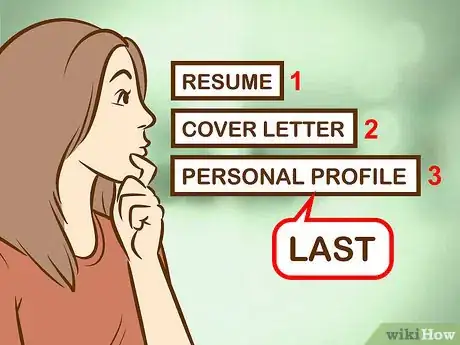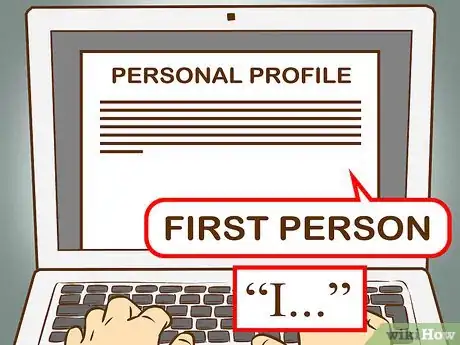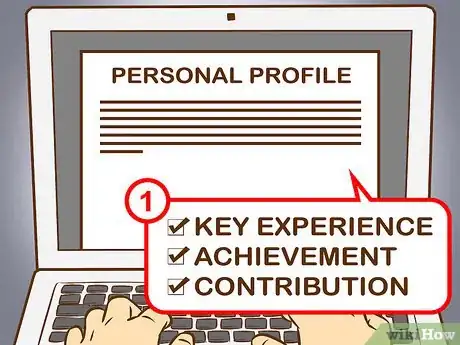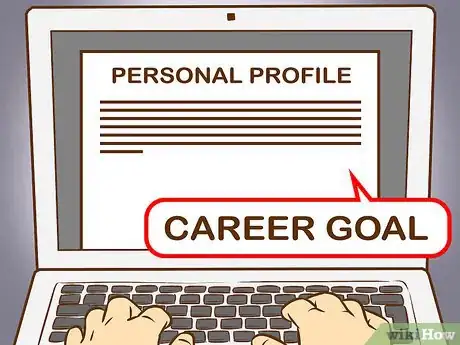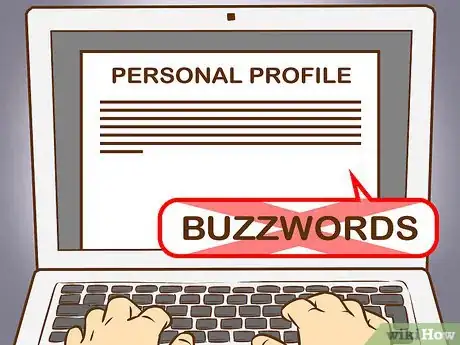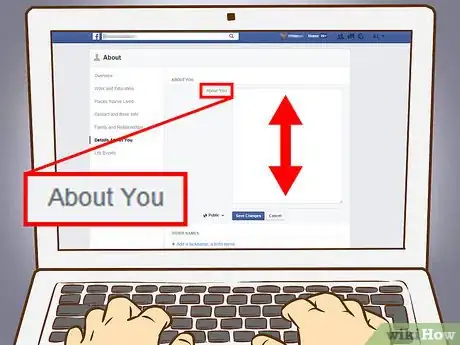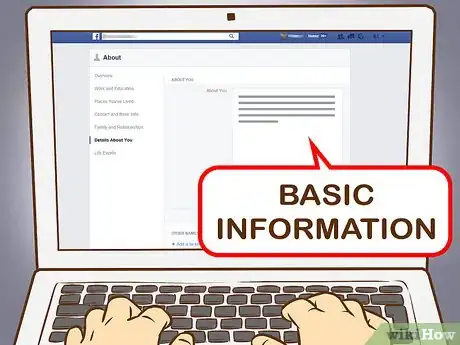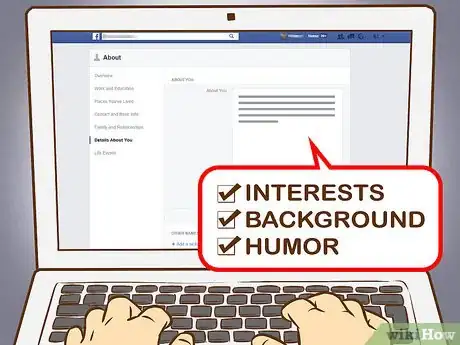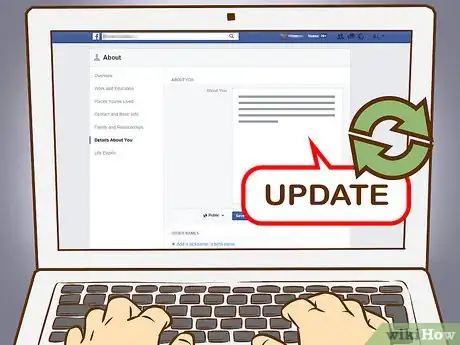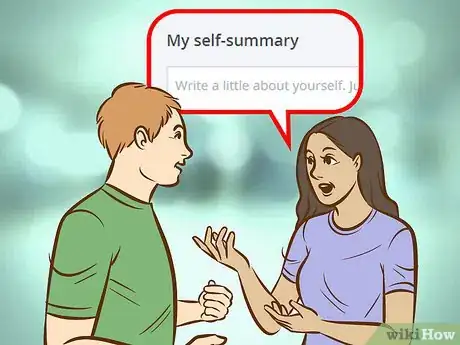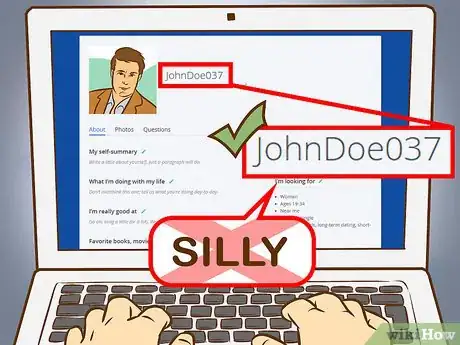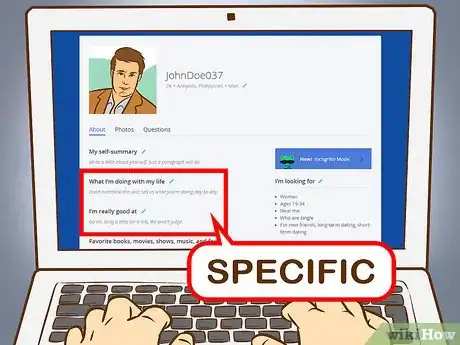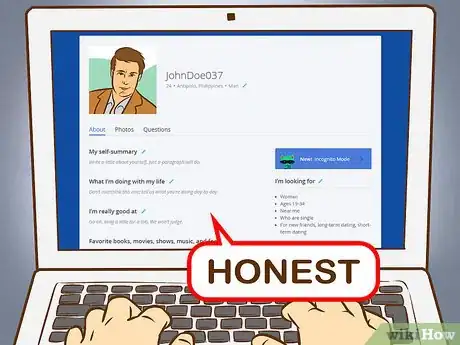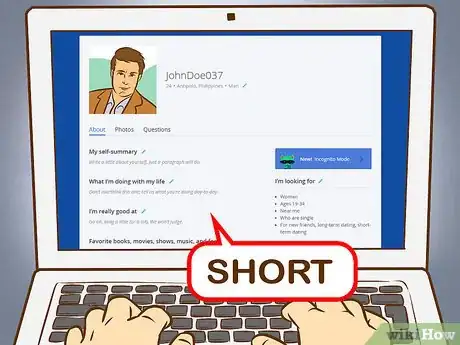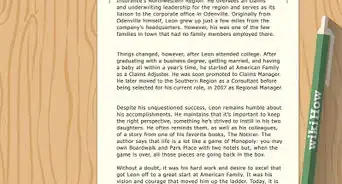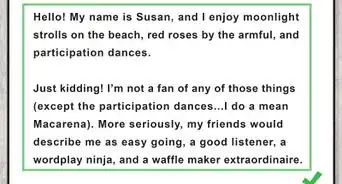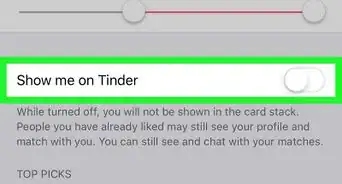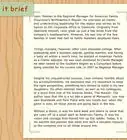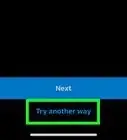This article was co-authored by A.J. Aldana. A.J. Aldana is a social media specialist who has been using platforms such as Tik Tok, Instagram, and YouTube for over 5 years. A.J. has worked with brands to curate content that has garnered thousands of interactions for various social media campaigns and is passionate about contributing to innovative and trending articles on wikiHow. He holds a BS in Product Design from Stanford University.
There are 14 references cited in this article, which can be found at the bottom of the page.
This article has been viewed 655,916 times.
No matter what type of online platform you’re using, the profile description you write will go a long way toward determining how others evaluate you. If you’re creating a profile for an online job application or a professional social media account, it’s critical for it to be concise, well-written, and informative, all while revealing some of your personality. Purely personal profiles (such as for personal social media accounts or dating sites) can be less rigid, but it still pays to take your time in crafting your message.
Steps
Job Application Profiles
-
1Write an attention-grabbing profile, not a summary of your CV. The purpose of a personal profile is to grab the reader’s attention as soon as they start reading your resume. Along with your cover letter, it’s your chance to draw in the reader, identify your key skills and achievements for them, and entice them to want to know more about you.[1]
- Your personal profile is a short introduction to the skills and experience listed on your resume or CV. It should not restate or repeat all the details in your resume or cover letter.
- It should be around 50-200 words, or around 4-6 lines.
- Put it at the beginning of your CV.
-
2Work on the profile after finishing your CV and cover letter. It’s tough to condense your career experiences and goals into a few sentences! To make it a little easier, focus first on your CV/resume and cover letter, then use what you’ve included there to help you tackle the personal profile. You’ll have a much better idea of what your key skills, experiences, and goals are, and your value as an applicant.
- Writing the personal statement last is like writing the introduction to an essay last—it helps clarify the content, phrasing, and claims that you should include.[2]
- If you still aren’t sure what your career aims and goals are, it’s better to avoid including a personal profile at the start of your CV. No personal profile is better than a vague or dull profile.[3]
Advertisement -
3Write in the first person with “I”-focused statements. Using the first person creates a stronger and more direct profile. It also makes it clear that you’re the one writing about your skills and goals! Most of your sentences should either start with “I” or silently assume the “I”—such as in the following examples:
- “I am a highly-motivated copy editor at renowned publishing house ABC Press with a proven track record of providing expert editing services in a wide range of subjects and writing styles, including technical documents and educational texts.”[4]
- “Highly-motivated copy editor at renowned publishing house ABC press. Proven track record of providing expert editing services in a wide range of subjects and writing styles, including technical documents and educational texts.”[5]
-
4Include a key experience, achievement, and contribution. It’s not necessary to provide exactly one of each, but doing so often makes for a good profile statement. Highlight the items in your background that put you in the most positive light vis-a-vis the position you’re applying for. Overcome any hesitancy you may have about “bragging” about your achievements—keep in mind that your goal here is to entice your reader to pay attention to your application.[6]
- For example, to highlight a recent internship you completed or are currently doing, you might state: “As an intern at Literary Arts, I contributed content to several projects, such as their award winning reading series and their educational outreach program. Drawing on my excellent communication skills, I developed and maintained successful working relationships with the staff and the participants.”
-
5State your career aim or goal in specific terms. It’s important to be clear about what you are working towards in your career and what you hope to gain from the possible position. Make sure your career aim or goal relates back to the position. This shows you understand what the position is and how it will help you achieve your career goal.[7]
- For example: “I am looking to secure a position at a top tier publishing house, where I can bring immediate and strategic value and develop my current skill set further.”
-
6Keep an eye out for overused buzzwords to avoid. This is a bit of a tricky fine-line to walk. Some of the phrases you may want to use, like “dynamic,” “extensive experience,” and “team player,” are so vague and overused that they may turn off the reader. Instead, work to come up with terms that are more specific to your resume and your career aim or goal.[8]
- For example, a bland, buzzword filled personal profile might include: “I am an energetic and dynamic person who enjoys a challenge and achieving personal goals. My present career aim is to work in publishing because I like reading and writing.”
- A more specific, interesting, and successful personal profile might include: “I am a motivated and detail-oriented professional editor looking to secure a position at a top tier publishing house, where I can bring immediate and strategic value and develop my current skill set.”
- Look for lists of buzzwords to avoid on professional sites like LinkedIn.[9]
-
7Confirm that your personal profile complements your CV and cover letter. Read over your completed personal profile to make sure it matches the skills and experiences discussed in your CV/resume and cover letter. Remember that, rather than repeating the points in your resume, your personal profile should act as an intriguing summary of your career goals and your skills.[10]
- Read it out loud for flow and tone, and check carefully for typos!
- Ask colleagues and mentors to read it and offer suggestions.
- Attach it to the top of your resume and send it out with your cover letter.
Professional Social Media Profiles
-
1Keep your profile short, even if you have a large word count available. Some social media platforms offer only limited word counts for profiles, while others provide unlimited space. That said, the most effective profiles are concise and to the point. Consider writing your profile for the platform with the most limited word count first, then expanding on it only slightly and as needed so it specifically suits each of the other platforms you use.[11]
- To name a few examples, Facebook offers an “About You” section, including the freeform “Write About Yourself” prompt, with no cap on word count. Twitter limits your bio to 160 characters, plus space for a link and your location. LinkedIn has a headline section, a summary section, and a section for your resume and skills.
-
2Check out examples of strong social media profiles for inspiration. Look up professional social media profiles on several platforms that use a limited word count to their advantage. Take special note of profiles that do a great job of distilling who the person is, what they do, and what they’re aiming to achieve into a small word count. No, it’s not an easy task, but it’s doable!
- For example: “Even though I am a PR person by trade, I’ll always be a reporter at heart. I’m incapable of pitching something I myself don’t believe in. I have a passion for uncovering unique and compelling ways that people are using a product, service, or site and revel in knowing that I can help thousands of people tell their story.” This profile is specific, assertive, and professional, while also including some relevant personal details.[12]
-
3Include basic information about yourself. Start by making a list of your basic information, like your name, your current position, and your general professional aims. Especially since this is a professional profile, don’t include anything too personal—just provide the basics to introduce yourself and give readers an idea of what they can expect from your social media account.[13]
- If you’re a baker who owns your own neighborhood bakery, write that down. If you’re a mechanic who specializes in Italian sports cars , start with that. Put the basic details down first, then work toward crafting it into an eye-catching profile.
-
4Sprinkle in some personality, such as a dash of humor. You do want to keep things professional here, but a little humor can go a long way towards personalizing you. Don’t try to manufacture jokes or a sense of personality that doesn’t suit you, however. Offer an authentic indication of who you are.[14]
- If you enjoy self-deprecating humor, for instance, you might identify yourself as a writer who “is sorry/not sorry about correcting your grammar” or a grad student who is “addicted to caffeine in all its forms.”
- Compare the following examples: “Jane Doe, writer based in California. Also tweets for ABC Press @ABCPress.” “Jane Doe, word junkie, living the dream in California. Find more of my witty (but clean) tweets @ABCPress.”
-
5Fine-tune and tighten up your profile so it really hits the mark. These few words can really be a big deal, so give them the time they deserve! Keep working and re-working your profile statement until it’s succinctly informative and remains professional while also revealing some of your personality. Always keep in mind how it is that you want your followers or readers to view you based on this profile statement.[15]
- Consider, for example, the further refinement of the following: “Jane Doe, word junkie, living the dream in California. Find more of my witty (but clean) tweets @ABCPress.” “Jane Doe, word addict, lover of West Coast living, 24/7 sun, and tacos. Also in charge of witty tweets for ABC Press @ABCPress.” However, if that ends up being a bit too casual, it might be best to revert to something like this: “Jane Doe, word enthusiast, based in California, also tweets for ABC Press @ABCPress.”
-
6Re-work your profile statement often. As your skills, interests, and expertise evolve, so should your bio. Check it every few months, if not monthly, to make sure it still reflects you. Paying attention to your personal profile on social media shows that you care about how you present yourself.[16]
- Keep your profile up-to-date at all times. If you change jobs, relocate, or embark on a new professional venture, update the relevant info right away.
Personal Social Media Profiles
-
1Ask close friends how they would describe you. It can be difficult to describe yourself well in words. Ask your friends what words and phrases come to mind when they think of you, then look for ways to incorporate these into your profile. After all, a close friend may know you better than you know yourself![17]
- If 4 out of 5 friends call you “witty,” it’s a sure sign that you should include that in your profile.
- This exercise is helpful when writing any kind of social media profile description, but can be really beneficial if you’re writing a profile for a dating or relationship site.
-
2Make sure your profile name, phrasing, and style suit you. For instance, say you’re trying to come up with a profile name for a dating site. Names like “SpunkyHunk” or “HotMinx” may have been funny back in high school, but silly or overly sexual profile names will only signal to others that you aren’t interested in a serious connection or relationship. Instead, choose a profile name that shows off your personality but still feels grown up. You can also abbreviate your name for an easy profile name. For example: “SuperSteph13” or “BradW.”[18]
- The same goes for any profile pictures you add. Make sure it reflects who you are—or at least reflects the way you want to be represented on social media!
-
3Include some specific, rather than generic, details. No, this doesn’t mean revealing personal details that could cause you trouble. What it does mean is letting your personality shine through. For example, don’t simply mention hobbies like “walking on the beach” or “drinking on the weekend.” Instead, think of interesting hobbies that could be conversation starters, like “addicted to traveling in South America” or “fan of early Battlestar Galactica.”[19]
- Focus on concrete and specific details, like your favorite books, films, celebrities, or sports. Rather than noting “hockey,” list your favorite hockey team, or rather than noting “thrillers,” list your favorite action novel.
-
4Be honest and clear, especially in a dating profile. Honesty is the best policy in any dating situation, especially online dating. Lying in your profile will make for a very awkward face to face meeting if things end up progressing with a potential mate. So be honest and upfront about yourself.[20]
- Be clear about what you want without making hyper-specific demands. Instead of, “I’m looking for a tall, strong, outdoorsy, vegan and gluten free guy to sweep me off my feet and be a father of my three future children,” try, “I believe in love and in being respectful and honest with my partner. I’m seeking someone who shares my interests and is serious about a relationship.”
-
5Keep the profile short and sweet. Even if a site gives you unlimited space for your profile, aim to keep it (in most cases) in the 50-200 word range, or even less if there are tighter space limits. Stick to the main points of your biography and your primary interests and goals. Avoid rambling on for paragraphs about yourself![21]
- Rightly or wrongly, people will make quick judgments about you based on your profile. If it rambles on instead of getting to the point in an insightful way, people will quickly lose interest.
-
6Proofread your grammar and spelling. Yes, this is a social media profile description, not a college essay, so you don’t have to be a stickler for the rules! That said, unintentionally bad grammar and spelling can turn people off and lead them to make quick judgments about you. If it seems like you didn’t put any time and effort into writing your profile, why should they bother wanting to get to know you better?
- Let a friend read over your profile before you post it. Or try pasting it into a word processing program to check for grammar and spelling errors.
Community Q&A
-
QuestionWhat should you include in an online profile?
 A.J. AldanaA.J. Aldana is a social media specialist who has been using platforms such as Tik Tok, Instagram, and YouTube for over 5 years. A.J. has worked with brands to curate content that has garnered thousands of interactions for various social media campaigns and is passionate about contributing to innovative and trending articles on wikiHow. He holds a BS in Product Design from Stanford University.
A.J. AldanaA.J. Aldana is a social media specialist who has been using platforms such as Tik Tok, Instagram, and YouTube for over 5 years. A.J. has worked with brands to curate content that has garnered thousands of interactions for various social media campaigns and is passionate about contributing to innovative and trending articles on wikiHow. He holds a BS in Product Design from Stanford University.
Social Media Specialist It really depends on the level of privacy you want to adhere to. Generally, online profiles include your profession, or if you're a student, your hometown or where you're going to school. Then, you can include a one-sentence quote or motto that you live by.
It really depends on the level of privacy you want to adhere to. Generally, online profiles include your profession, or if you're a student, your hometown or where you're going to school. Then, you can include a one-sentence quote or motto that you live by. -
QuestionHow do I end a profile?
 Community AnswerThe profile should contain your favorite slogan or motto.
Community AnswerThe profile should contain your favorite slogan or motto. -
QuestionHow do I write in a profile about my family and siblings?
 MIKI WONG YU QI MoeCommunity AnswerDetermine how much space you have for each social media platform. Though some of these platforms may have a large word count, the most effective profiles will still be concise and to the point.
MIKI WONG YU QI MoeCommunity AnswerDetermine how much space you have for each social media platform. Though some of these platforms may have a large word count, the most effective profiles will still be concise and to the point.
References
- ↑ https://www.careereducation.columbia.edu/resources/how-write-resume-profile-or-summary-statement
- ↑ https://writing.wisc.edu/handbook/process/introductions/
- ↑ https://www.prospects.ac.uk/careers-advice/cvs-and-cover-letters/writing-a-personal-statement-for-your-cv
- ↑ http://www.theguardian.com/careers/careers-blog/how-to-write-a-personal-statement-for-your-cv
- ↑ https://www.careereducation.columbia.edu/resources/how-write-resume-profile-or-summary-statement
- ↑ http://www.theguardian.com/careers/careers-blog/how-to-write-a-personal-statement-for-your-cv
- ↑ http://www.theguardian.com/careers/careers-blog/how-to-write-a-personal-statement-for-your-cv
- ↑ http://www.kent.ac.uk/careers/cv/CVProfiles.htm
- ↑ https://blog.linkedin.com/2010/12/14/2010-top10-profile-buzzwords
- ↑ http://www.theguardian.com/careers/careers-blog/how-to-write-a-personal-statement-for-your-cv
- ↑ https://medium.com/strategic-content-marketing/10-foolproof-ways-to-create-a-magnetic-social-media-bio-ebe608bbf1f9
- ↑ https://buffer.com/library/how-to-write-a-professional-bio-for/
- ↑ A.J. Aldana. Social Media Specialist. Expert Interview. 9 March 2021.
- ↑ https://www.socialmediatoday.com/social-networks/2015-02-18/how-write-magnetic-social-media-profile
- ↑ http://www.socialmediatoday.com/social-networks/2015-02-18/how-write-magnetic-social-media-profile
- ↑ http://www.socialmediatoday.com/social-networks/2015-02-18/how-write-magnetic-social-media-profile
- ↑ http://www.theguardian.com/lifeandstyle/2009/jan/24/internet-dating-profile-advice
- ↑ http://www.theguardian.com/lifeandstyle/2009/jan/24/internet-dating-profile-advice
- ↑ http://www.theguardian.com/lifeandstyle/2009/jan/24/internet-dating-profile-advice
- ↑ http://www.mindbodygreen.com/0-11494/how-to-write-a-deliciously-effective-online-dating-profile.html
- ↑ http://www.mindbodygreen.com/0-11494/how-to-write-a-deliciously-effective-online-dating-profile.html
About This Article
To write a personal profile outline for an application, use "I" instead of "he" or "she" to create a strong and direct voice. Additionally, include one key experience, achievement, or contribution to highlight. You should also be clear about your career aim or goal, and what you hope to gain from the position you’re applying for. Once you draft your profile, read it out loud for flow and tone, check that it’s under 200 words, and attach it to the top of your resume. To learn how to avoid buzzwords in your personal profile, keep reading!

